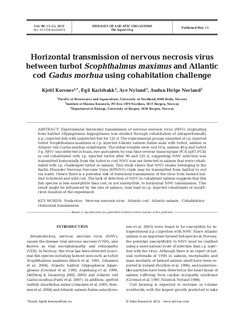| dc.contributor.author | Korsnes, Kjetil | |
| dc.contributor.author | Karlsbakk, Egil | |
| dc.contributor.author | Nylund, Are | |
| dc.contributor.author | Nerland, Audun H. | |
| dc.date.accessioned | 2012-11-13T18:26:15Z | |
| dc.date.issued | 2012-05-15 | |
| dc.identifier.issn | 0177-5103 | |
| dc.identifier.issn | 1616-1580 | |
| dc.identifier.uri | http://hdl.handle.net/11250/109150 | |
| dc.description.abstract | Experimental horizontal transmission of nervous necrosis virus (NNV) originating
from halibut Hippoglossus hippoglossus was studied through cohabitation of intraperitoneally
(i.p.) injected fish with uninfected fish for 125 d. The experimental groups consisted of i.p. injected
turbot Scophthalmus maximus or i.p. injected Atlantic salmon Salmo salar with turbot, salmon or
Atlantic cod Gadus morhua cohabitants. The initial weights were cod 10 g, salmon 40 g and turbot
3 g. NNV was detected in brain, eye and spleen by real-time reverse transcriptase PCR (qRT-PCR)
in cod cohabitated with i.p. injected turbot after 90 and 125 d, suggesting NNV infection was
transmitted horizontally from the turbot to cod. NNV was not detected in salmon that were cohabitated
with i.p. challenged turbot or salmon. This study shows that NNV strains belonging to the
Barfin Flounder Nervous Necrosis Virus (BFNNV) clade may be transmitted from halibut to cod
via water. Hence there is a potential risk of horizontal transmission of the virus from farmed halibut
to farmed and wild cod. The lack of detection of NNV in cohabitant salmon suggests that this
fish species is less susceptible than cod, or not susceptible, to horizontal NNV transmission. This
result might be influenced by the size of salmon, viral load in i.p. injected cohabitants or insufficient
duration of the experiment. | no_NO |
| dc.language.iso | eng | no_NO |
| dc.publisher | Inter-Research | no_NO |
| dc.subject | atlantic cod | no_NO |
| dc.subject | atlantisk torsk | no_NO |
| dc.subject | atlantic salmon | no_NO |
| dc.subject | atlantisk laks | no_NO |
| dc.subject | transmission | no_NO |
| dc.subject | smitte | no_NO |
| dc.subject | nodavirus | no_NO |
| dc.title | Horizontal transmission of nervous necrosis virus between turbot Scophthalmus maximus and Atlantic cod Gadus morhua using cohabitation challenge | no_NO |
| dc.type | Journal article | no_NO |
| dc.type | Peer reviewed | no_NO |
| dc.subject.nsi | VDP::Agriculture and fishery disciplines: 900::Fisheries science: 920::Resource biology: 921 | no_NO |
| dc.subject.nsi | VDP::Mathematics and natural science: 400::Geosciences: 450::Oceanography: 452 | no_NO |
| dc.subject.nsi | VDP::Agriculture and fishery disciplines: 900::Fisheries science: 920::Fish health: 923 | no_NO |
| dc.description.embargo | 2017-05-15 | |
| dc.source.pagenumber | 13-21 | no_NO |
| dc.source.volume | 99 | no_NO |
| dc.source.journal | Diseases of Aquatic Organisms | no_NO |
| dc.source.issue | 1 | no_NO |
| dc.identifier.doi | http://dx.doi.org/10.3354/dao02454 | |
